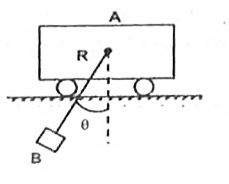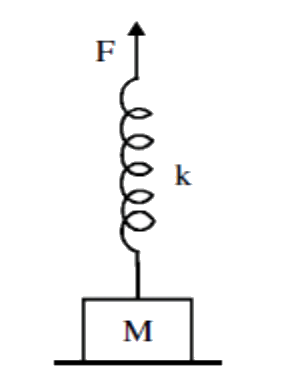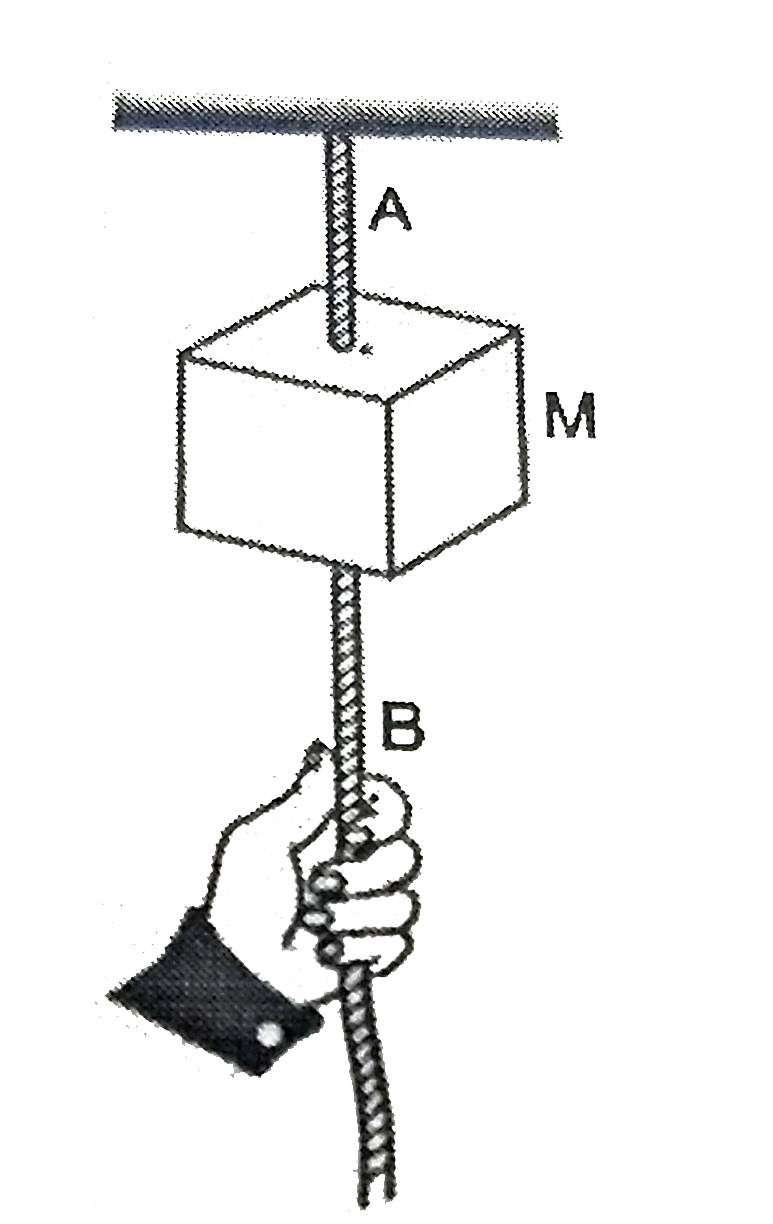A block of mass m is suspended by a rubber cord of natural length l=mgk, where k is force constant of the cord. The block is lifted upwards so that the cord becomes just tight and then block is released suddently. Which of the following will not be true?
Block performs periodic motion with amplitude greater than l.
Block performs SHM with amplitude equal to l.
Blocks will never return to the position from where it was released.
Angular frequency ω is equal to 1rads
The correct Answer is:A, C, D
When the block is released suddenly, it starts to move down. During its downwards motion the rubber coed elongates. Hece, a tension is developed in it but the blocks continues to accelerate downwards till tension becomes equal to weight mg of the block. After this moment, the block continues to move down due to its velocity and rubber cord further elongates. Therefore tension becomes greater than the weight, hence, the block now retards and comes to an instantaneous rest. At lowest position of the block, strain energy in the cord equals loss of potential energy of the block. Suppose the block comes to an instantaneous rest when elongation of the rubber cord is equl to y. Then
12ky2=mgy⇒y=2mgk and 0
Hence block will be instantaneously at rest, at y=0 and at y=2mgk. If fact, the block oscillates between these two values. Since the rubber cord is elastic, tension in it is directily proportional to elongation therefore, the block will perform SHM. Its amplitude will be equal to half of the distance between these extreme positions of the block or amplitude is
12×2mgk=mgk=l
Hence option (b) is correct.
The angular frequency of its SHM will be equal to
ω=√km
Since k and m are not given in the question, it cannot be calculated. Hence option (d) is not correct.
Related Playlists
- BOOK - CENGAGE PHYSICS ENGLISHCHAPTER - LINEAR AND ANGULAR SIMPLE HARMONIC MOTIONEXERCISE - Assertion Reasoning6videos
LINEAR AND ANGULAR SIMPLE HARMONIC MOTION
- BOOK - CENGAGE PHYSICS ENGLISHCHAPTER - LINEAR AND ANGULAR SIMPLE HARMONIC MOTIONEXERCISE - Comprehension33videos
LINEAR AND ANGULAR SIMPLE HARMONIC MOTION
- BOOK - CENGAGE PHYSICS ENGLISHCHAPTER - LINEAR AND ANGULAR SIMPLE HARMONIC MOTIONEXERCISE - Single Correct107videos
LINEAR AND ANGULAR SIMPLE HARMONIC MOTION
- BOOK - CENGAGE PHYSICS ENGLISHCHAPTER - KINETIC THEORY OF GASES AND FIRST LAW OF THERMODYNAMICSEXERCISE - Interger11videos
KINETIC THEORY OF GASES AND FIRST LAW OF THERMODYNAMICS
- BOOK - CENGAGE PHYSICS ENGLISHCHAPTER - MISCELLANEOUS KINEMATICSEXERCISE - Interger type3videos
MISCELLANEOUS KINEMATICS
Similar Questions
A block B of mass M is suspended from a cord of length l attached to a cart A of mass M as shown in the figure. The horizontal surface on which the cart moves is smooth. Initially both the cart and the block are at rest in the position shown. Now B is released. Take M=m=2kg,θ=45∘andg=10m/s2.

The tension in the cord immediately after the system is released from rest isView SolutionA block B of mass M is suspended from a cord of length l attached to a cart A of mass M as shown in the figure. The horizontal surface on which the cart moves is smooth. Initially both the cart and the block are at rest in the position shown. Now B is released. Take M=m=2kg,θ=45∘andg=10m/s2.

The tension in the cord immediately after the system is released from rest isView SolutionA block of mass M is kept on a rough horizontal surface and is attached with massless spring of force constant k .The minimum constant force applied on the other end of the spring to lift the block is
View SolutionA block of mass m is kept on a rough horizontal surface and is attached with a massless spring of force constant k. The minimum constant force applied on the other end of the spring of lift the block is
 View Solution
View SolutionA block of mass 2kg is connected with a spring of natural length 40cm of force constant K=200N/m. The cofficient of friction is μ=0.5. When released from the given position, acceleration of block will be
 View Solution
View SolutionA block of mass 2kg is connected with a spring of natural length 40cm of force constant K=200N/m. The cofficient of friction is μ=0.5. When released from the given position, acceleration of block will be
 View Solution
View SolutionA block of mass m is suspended from a fixed support with the help of a cord. Another identical cord is attached to the bottom of the block. Which of the following statement is/are true?
View SolutionA block of mass m is suspended from a fixed support with the help of a cord. Another identical cord is attached to the bottom of the block. Which of the following statement is/are true?
View SolutionA block of mass M is suspended by a corf A from the ceiling and another cord B is attached to the bottom of the block as shown in Which string will break if we pull the string B
(a) with a sudden jerk,
(b) steadily ?
 View Solution
View SolutionA block of mass M connected to an ideal spring of force constant k, is placed on a smooth surface. The block is pushed to the left so as to compress the spring by a length A and then it is released. The block hits an elastic wall at a distance 3A2 from its point of release. Assume the collision to be instantaneous.
(a) Calculate the time required by the block to complete one oscillation
(b) Draw the velocity - time graph for one oscillation of the block.
(c) Find the value of k for which average force experienced by the wall due to repeated hitting of the block is F0.
 View Solution
View Solution

